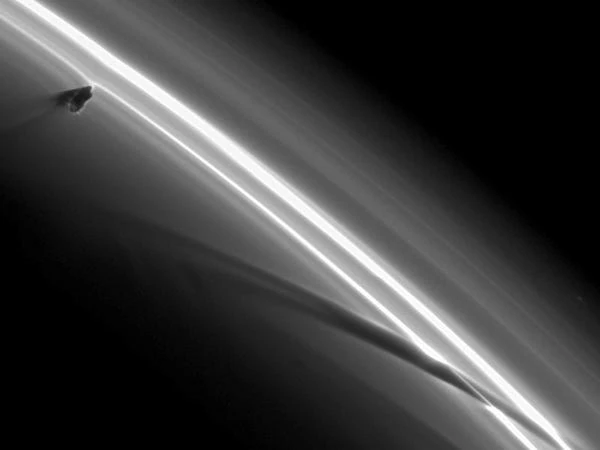
Image description: The gravitational field of the tiny moon Prometheus creates dark waves visible in this image of Saturn's F ring. The rings (A, B, C, D, E, F, G) are located inside or near the Roche limit for fluid bodies. Prometheus attracts fine particles of icy dust around it, causing these dark waves of absent material. Prometheus creates a new stream with each passage, so sometimes several of them are visible simultaneously. Image credit: Cassini Imaging Team, ISS, JPL, ESA, NASA
All aggregates of a celestial body are held together by their own gravitational force. The Roche Limit or Roche Radius is the distance at which a small celestial body will disintegrate due to the tidal forces of another celestial body whose attractive force exceeds the self-attraction of the small body. In other words, the Roche Limit is the minimum distance, relative to the center of the planet, that allows matter to gather to form, for example, a sufficiently large moon.
Tidal forces prevent the formation of a massive body near the planet. A certain distance is necessary for dust and small debris to "stick together" and form a very massive object. This distance is called the Roche Limit, named after the French mathematician and astronomer Édouard Albert Roche (1820-1883), who calculated this theoretical limit in 1848.
Below this limit, an object begins to break apart because the action of tidal forces overcomes the cohesive forces of the materials constituting the object. Beyond this limit, tidal forces only produce friction between the materials of the satellite and the planet. This generally produces a bulge on the surface of the objects.
A rigid body is a solid object that maintains its shape and structure under the effect of tidal forces. A fluid body is an object that can easily deform under the effect of tidal forces, such as an ocean or a satellite composed of fluid materials. The Roche limit for rigid bodies is located for two bodies of the same density at ≈2.42 times the radius of the planet. For fluid bodies, it is located for two bodies of the same density at ≈1.26 times the radius of the planet.
N.B.:
Around the planets of the Solar System, within the Roche limit, only rings or very small, low-mass bodies are found.
Roche limit for rigid bodies: d= 2.422849865 x R x 3√ρM/ρm
- d = Roche limit
- R = radius of the planet
- ρM = density or volumetric mass of the planet
- ρm = density or volumetric mass of the moon
Excel formula for calculation: =(2.422849865*R)*(ρM/ρm)^(1/3)
Roche limit for fluid bodies: d = 1.26 x R x 3√ρM/ρm
Excel formula for calculation: =(1.26*R)*(ρM/ρm)^(1/3)
The tidal forces exerted by the planet slowly decelerate the satellite when it is within the Roche limit. The moon gradually loses altitude and can disintegrate upon reaching the Roche limit, thus forming a new planetary ring. Conversely, beyond the Roche limit, tidal forces very slowly accelerate the satellite and move it away, as is the case with the Moon, which is moving away from Earth by 3.78 cm per year.
Several moons in the solar system are dangerously approaching the Roche limit of their planet, and their end is programmed. If they do not disintegrate upon approaching the Roche limit, they will ignite in the atmosphere of their planet. This is notably the case for Phobos (moon of Mars), Amalthea and Metis (moons of Jupiter), Prometheus and Pandora (moons of Saturn), Cordelia and Ophelia (moons of Uranus), and Galatea, Thalassa, Despina, or Naiad (moons of Neptune).
| Moons near the limits | Roche limit (rigid) | Roche limit (fluid) |
| number of Roche radius | number of Roche radius | |
| Phobos (Mars) | 1.72 | 0.89 |
| Amalthea (Jupiter) | 1.74 | 0.91 |
| Thebe (Jupiter) | 2.13 | 1.11 |
| Metis (Jupiter) | 1.23 | 0.64 |
| Adrastea (Jupiter) | 1.24 | 0.64 |
| Prometheus (Saturn) | 1.63 | 0.85 |
| Pandora (Saturn) | 1.67 | 0.87 |
| Mimas (Saturn) | 2.90 | 1.51 |
| Cordelia (Uranus) | 1.54 | 0.80 |
| Ophelia (Uranus) | 1.66 | 0.86 |
| Bianca (Uranus) | 1.83 | 0.95 |
| Cressida (Uranus) | 1.91 | 0.99 |
| Desdemona (Uranus) | 1.94 | 1.01 |
| Juliet (Uranus) | 1.99 | 1.03 |
| Portia (Uranus) | 2.04 | 1.06 |
| Larissa (Neptune) | 2.12 | 1.11 |
| Galatea (Neptune) | 1.53 | 0.80 |
| Despina (Neptune) | 1.52 | 0.79 |
| Thalassa (Neptune) | 1.45 | 0.75 |
| Naiad (Neptune) | 1.43 | 0.74 |